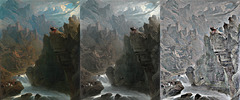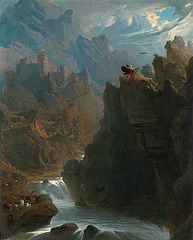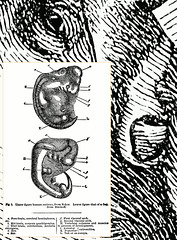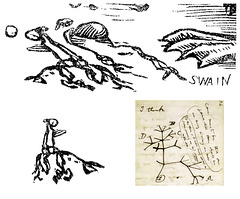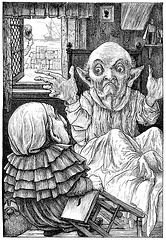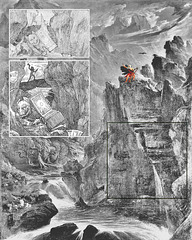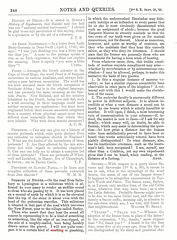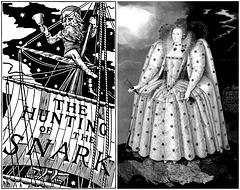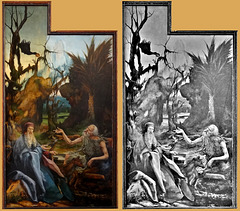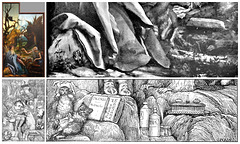
Snark Updates
Folder: The Hunting of the Snark
Updates
2014-08-16 and later:
Mostly addtl. comments or changes in comments
About my Snark hunt
| |
|
|
===== How I got into Snark hunting =====
In December 2008, I searched for “Hidden Faces” in the Wikipedia . I wanted to see whether an illustration by Henry Holiday (left) to Lewis Carroll’s The Hunting of the Snark was mentioned there. (Now it is.) But instead of that I found Gheeraert's Allegory of Iconoclasm (right, aka The Image Breakers ) in the Wikipedia article on hidden faces. And then I saw a little rhombic pattern in the “mouths” of the “heads” depicted in both illustrations. The Snark hunt had begun.
left:
2009: Illustration by Henry Holiday to fit the eight in Lewis Carroll's The Hunting of the Snark
(This is the 2007 version of an image in ebooks.adelaide.edu.au/c/carroll/lewis/snark/#fit8 .)
center:
2008-12-16: Detail from "Hidden Faces" in en.wikipedia.org,
en.wikipedia.org/w/index.php?title=Hidden_faces&oldid=258354510
right:
Marcus Gheeraerts the Elder, Allegory of Iconoclasm , c.1566–1568 etching 15” x 10.4”, British Museum, London.
commons.wikimedia.org/wiki/File:Gheerhaets_Allegory_iconoclasm.jpg
(In December 2008 the image was smaller: upload.wikimedia.org/wikipedia/commons/archive/f/f5/20100214083045!Gheerhaets_Allegory_iconoclasm.jpg , but even there you can see the detail which cought my attention.)
(The blur is intentional. It removes unecessary details.)
The second Snark finding
John Martin' s "The Bard" prepared for analysis
| |
|
|
Source of the painting on the left side:
deliver.odai.yale.edu/content/id/594cf828-e6b8-4ec4-bf14-cac45880305d/format/3
left: John Martin, The Bard
center: desaturated, increased contrast of large dark area (rocks) on the right side
right: GIMP, Retinex filtering: Scale=160, ScaleDivision=6, Dynamic=2.5
=====================
John Martin: The Bard
ca. 1817
Yale Center for British Art, Paul Mellon Collection
collections.britishart.yale.edu/vufind/Record/1671616 :
"Based on a Thomas Gray poem, inspired by a Welsh tradition that said that Edward I had put to death any bards he found, to extinguish Welsh culture; the poem depicts the escape of a single bard.
In mydailyartdisplay.wordpress.com/the-bard-by-john-martin , "Jonathan" connects the painting to the poem The Bard written by by Thomas Gray in 1755:
· · ...
· · On a rock, whose haughty brow
· · Frowns o'er cold Conway's foaming flood,
· · Robed in the sable garb of woe
· · With haggard eyes the Poet stood;
· · ...
· · "Enough for me: with joy I see
· · The diff'rent doom our fates assign.
· · Be thine Despair and sceptred Care;
· · To triumph and to die are mine."
· · He spoke, and headlong from the mountain's height
· · Deep in the roaring tide he plunged to endless night.
· · ...
The poem and the painting may have been an inspiration to Lewis Carroll and Henry Holiday in The Hunting of the Snark:
· · 545 · · Erect and sublime, for one moment of time.
· · 546· · · · In the next, that wild figure they saw
· · 547· · (As if stung by a spasm) plunge into a chasm,
· · 548· · · · While they waited and listened in awe.
Album:
John Martin
John Martin - The Bard
| |
|
|
|
recto, unframed
deliver.odai.yale.edu/content/id/594cf828-e6b8-4ec4-bf14-cac45880305d/format/3
=====================
John Martin: The Bard
ca. 1817
Yale Center for British Art, Paul Mellon Collection
collections.britishart.yale.edu/vufind/Record/1671616 :
"Based on a Thomas Gray poem, inspired by a Welsh tradition that said that Edward I had put to death any bards he found, to extinguish Welsh culture; the poem depicts the escape of a single bard.
In mydailyartdisplay.wordpress.com/the-bard-by-john-martin , "Jonathan" connects the painting to the poem The Bard written by by Thomas Gray in 1755:
· · ...
· · On a rock, whose haughty brow
· · Frowns o'er cold Conway's foaming flood,
· · Robed in the sable garb of woe
· · With haggard eyes the Poet stood;
· · ...
· · "Enough for me: with joy I see
· · The diff'rent doom our fates assign.
· · Be thine Despair and sceptred Care;
· · To triumph and to die are mine."
· · He spoke, and headlong from the mountain's height
· · Deep in the roaring tide he plunged to endless night.
· · ...
The poem and the painting may have been an inspiration to Lewis Carroll and Henry Holiday in The Hunting of the Snark:
· · 545 · · Erect and sublime, for one moment of time.
· · 546· · · · In the next, that wild figure they saw
· · 547· · (As if stung by a spasm) plunge into a chasm,
· · 548· · · · While they waited and listened in awe.
·
See also: Henry Holiday's Snark illustrations and John Martin's "The Bard":
- www.academia.edu/9885417/The_Bellman_and_the_Bard
- www.academia.edu/9923718/Henry_Holidays_Monsterspotting
- www.academia.edu/10251338/Monsters_and_Monstrances
- www.academia.edu/12586460/The_Bard_the_Baker_and_the_Butcher
John Martin's Bard and Henry Holiday's Snark Illus…
| |
|
|
|
top left: John Martin, The Bard (1817).
top right: John Martin, The Bard modified using GIMP, Retinex: Scale=160, ScaleDivision=6, Dynamic=2.5
bottom left: Illustration (1876) by Henry Holiday to Lewis Carroll's The Hunting of the Snark , Fit 8. Changes: GIMP "delate" applied in order to yield a less darker printing.
bottom right: Illustration (1876) by Henry Holiday to Lewis Carroll's The Hunting of the Snark , Fit 5
4800 px × 6500 px
20.3 cm × 27.5 cm (@ 600 dpi)
=====================================================
John Martin: The Bard
ca. 1817
Yale Center for British Art, Paul Mellon Collection
collections.britishart.yale.edu/vufind/Record/1671616 :
"Based on a Thomas Gray poem, inspired by a Welsh tradition that said that Edward I had put to death any bards he found, to extinguish Welsh culture; the poem depicts the escape of a single bard.
In mydailyartdisplay.wordpress.com/the-bard-by-john-martin , "Jonathan" connects the painting to the poem The Bard written by by Thomas Gray in 1755:
· · ...
· · On a rock, whose haughty brow
· · Frowns o'er cold Conway's foaming flood,
· · Robed in the sable garb of woe
· · With haggard eyes the Poet stood;
· · ...
· · "Enough for me: with joy I see
· · The diff'rent doom our fates assign.
· · Be thine Despair and sceptred Care;
· · To triumph and to die are mine."
· · He spoke, and headlong from the mountain's height
· · Deep in the roaring tide he plunged to endless night.
· · ...
The poem and the painting may have been an inspiration to Lewis Carroll and Henry Holiday in The Hunting of the Snark:
· · 545 · · Erect and sublime, for one moment of time.
· · 546· · · · In the next, that wild figure they saw
· · 547· · (As if stung by a spasm) plunge into a chasm,
· · 548· · · · While they waited and listened in awe.
Album:
John Martin
The Banker and The Bonnetmaker
| |
|
|
Ear & Embryo
| |
|
|
Background: Rotated detail from an illustration by Henry Holiday to Lewis Carroll's The Hunting of the Snark
Foreground: From Charles Darwin's The Descent of Man
- en.wikipedia.org/wiki/The_Descent_of_Man,_and_Selection_in_Relation_to_Sex
- commons.wikimedia.org/wiki/Descent_of_Man_%28A._L._Burt_edition%29
The Banker is one of the members of the Snark hunting party. Henry Holiday can draw ears. If the Banker's ear looks strange it is meant to look strange.
jub jub jub jub jub jub jub jub jub jub jub jub ..…
| |
|
|
Size Height: 17.6 cm (6.9 in) Width: 20.8 cm (8.2 in) Depth: 20.8 cm (8.2 in)
Location Room 39 case 10
Description: The Beagle chronometer. In the British Museum.
Maker: Thomas Earnshaw
Date 27 June 2010
Photograph by Mike Peel ( www.mikepeel.net ).
See also: commons.wikimedia.org/wiki/File:British_Museum_Marine_Chronometer.jpg
For collecting time you don't need a subscription. And time doesn't take bribes.
381 · · “As to temper the Jubjub ’s a desperate bird,
382 · · · · Since it lives in perpetual passion:
383 · · Its taste in costume is entirely absurd—
384 · · · · It is ages ahead of the fashion:
385 · · “But it knows any friend it has met once before:
386 · · · · It never will look at a bribe :
387 · · And in charity-meetings it stands at the door,
388 · · · · And collects—though it does not subscribe.
389 · · “ Its flavour when cooked is more exquisite far
390 · · · · Than mutton, or oysters, or eggs:
391 · · (Some think it keeps best in an ivory jar ,
392 · · · · And some, in mahogany kegs :)
393 · · “You boil it in sawdust : you salt it in glue:
394 · · · · You condense it with locusts and tape:
395 · · Still keeping one principal object in view—
396 · · · · To preserve its symmetrical shape .”
See also:
※ www.academia.edu/9970930/Hunting_Snark_with_Charles_Darwin
※ www.quora.com/unanswered/Is-Lewis-Carrolls-%E2%80%9CJubjub%E2%80%9D-a-riddle-about-%E2%80%9Ctime%E2%80%9D-and-or-%E2%80%9Cchronometer%E2%80%9D
The Bellman and Charles Darwin
| |
|
|
|
1876 and around 1870.
If it was for this pairing only, I would not use this side-by-side image as an example for allusions to Charles Darwin (19th century portrait) in Lewis Carroll's and Henry Holiday's The Hunting of the Snark . Also, too obvious allusions to Darwin would have narrowed the interpretation space which Carroll wanted to leave to his readers. However, there is more .
Darwin portrait found in What Mr Darwin Saw in His Voyage Round the World in the Ship ‘Beagle’ , 1879.
»Extracts paraphrased by W.P. Garrison from Darwin’s Beagle diaries.
Son of a US abolitionist, W.P. Garrison published this work anonymously. His stated aim was to 'interest children in the study of natural history, and physical and political geography'. Garrison selected extracts from Darwin's original diaries, reorganising material thematically into four parts: 'Animals', 'Man' (strange peoples and customs, particularly of savage and barbarous life), 'Geography' (physical features of the countries visited by Mr Darwin) and 'Nature' (account of the grandeur of terrestrial processes).«
Source: University of Cambridge > Department of History and Philosophy of Science > Whipple Library > Rare book collections > Online exhibitions
Tree of Life
| |
|
|
Segment of an illustration by Henry Holiday (cut by Joseph Swain) in Lewis Carroll's The Hunting of the Snark , 1876
The segment on the lower right side is Charles Darwin's Tree of Evolution or Tree of Life sketch in his 1st notebook, page 36, 1837-1838. I learned, that Darwin did not keep his notebook secret after the publication of On the Origin of Species , but I do not know of any presentation of his sketch before 1876. Thus, the resemblance between the "weed" and Darwin's evolutionary tree sketch propably is purely incidental.
Postprocessing: GIMP perspective transformation tool
Questions:
(1) When did Charles Darwin publish a facsimile of his sketch fo the first time? When (e.g. in lectures etc.) was it presented for the first time?
(2) Or is there a completely different explanation? Holiday's "weed" also could allude to an eagle riding a wild boar .
h30
| |
|
|
From Henry Holiday's illustrations to Lewis Carroll's The Hunting of the Snark (1876)
Bellman & Bard after retinex filtering
| |
|
|
[main image]: John Martin: The Bard (ca. 1817) , by GIMP: contrast enhanced in the rock area & light areas delated & (most of) color removed & retinex filtering
[upper inset]: Detail from preperatory draft for Henry Holiday's illustration (1876) to chapter The Beaver's Lesson in Lewis Carroll's The Hunting of the Snark
[lower inset]: Henry Holiday: Illustration (1876) to chapter The Beaver's Lesson in Lewis Carroll's The Hunting of the Snark , detail
It seems, that initially Henry Holiday saw anthropomorphic "faces" in John Martin's rocks and used them in his draft. However, Holiday's final allusion to this part of John Martin's painting is different - and funnier.
As the for The Bard , the final Bellman comes closer to that figure than the drafted Bellman.
=== Literature ===
In mydailyartdisplay.wordpress.com/the-bard-by-john-martin , "Jonathan" connects the painting to the poem The Bard written by by Thomas Gray in 1755. Inspired by a Welsh tradition that said that Edward I had put to death any bards he found, to extinguish Welsh culture; the poem depicts the escape of a single bard:
· · ...
· · On a rock, whose haughty brow
· · Frowns o'er cold Conway's foaming flood,
· · Robed in the sable garb of woe
· · With haggard eyes the Poet stood;
· · ...
· · A Voice, as of the Cherub-Choir,
· · Gales from blooming Eden bear;
· · And distant warblings lessen on my ear,
· · That lost in long futurity expire.
· · Fond impious Man, think'st thou, yon sanguine cloud,
· · Rais'd by thy breath, has quench'd the Orb of day?
· · To-morrow he repairs the golden flood,
· · And warms the nations with redoubled ray.
· · "Enough for me: With joy I see
· · The different doom our Fates assign.
· · Be thine Despair, and scept'red Care,
· · To triumph, and to die, are mine."
· · He spoke, and headlong from the mountain's height
· · Deep in the roaring tide he plung'd to endless night.
· · ...
Full text:
www.thomasgray.org/cgi-bin/display.cgi?text=bapo
spenserians.cath.vt.edu/TextRecord.php?action=GET&tex...
www.english.upenn.edu/~mgamer/Etexts/gray.bard.html
www.google.com/search?q="A+Voice,+as+of+the+Cherub-Choir"
The poem and the painting may have been an inspiration to Lewis Carroll and Henry Holiday in The Hunting of the Snark . This is about The Vanishing of The Baker :
· · 537 · · "There is Thingumbob shouting!" the Bellman said,
· · 538 · · · · "He is shouting like mad, only hark!
· · 539 · · He is waving his hands, he is wagging his head,
· · 540 · · · · He has certainly found a Snark!"
· · 541 · · They gazed in delight, while the Butcher exclaimed
· · 542 · · · · "He was always a desperate wag!"
· · 543 · · They beheld him--their Baker--their hero unnamed--
· · 544 · · · · On the top of a neighbouring crag.
· · 545 · · Erect and sublime, for one moment of time.
· · 546 · · · · In the next, that wild figure they saw
· · 547 · · (As if stung by a spasm) plunge into a chasm,
· · 548 · · · · While they waited and listened in awe.
Album:
John Martin
Snarking or Gnashing
| |
|
|
See also: www.academia.edu/10407335/Scratching_or_Scranching_is_not_quite_like_Snarking_or_Gnashing_1866_
SERMONS IN STONES. -- On the road from Salisbury to Lymington is a milestone which is affirmed by very many to render an audible sound to those who are passing by it. It has been placed on a mound of earth by which it is so far elevated that the top of the stone is about even with the head of the pedestrian traveller. This milestone is situated in that part of the road which traverses the New Forest, near to the village called Burley.
Those who assert that they hear the sound all concur in representing it to be a kind of scratching or scranching, like the edge of an iron-tipped, or the sole of a roughly-nailed, boot being harshly drawn across the gravel. I will not quite compare it to a certain kind of snarking or gnashing, in which the undercrushed Enceladus may hideously indulge as an indication to every passer that he or she is most virulently discontented with such an assignment of abode; because the good Emperor Marcus so sweetly reminds us that the two rows of our teeth were given us for mutual concurrence, not for discord. About as numerous, however, and quite as worthy of credence, are they who maintain that they hear this uncouth salute, as they who deny its utterance. I should state that the former are generally those who are remarkable for having a keen sense of hearing.
From whatever cause, then, this irelike crassitude of restless wayside compliment may arise whether by reverberation or by subterraneous concitation I may be allowed, perhaps, to make this narrative the basis of two queries.
1. Is this a singular instance of saxeous vocality; or has a similar cippous eccentricity been observable in other parts of the kingdom ? A collateral suit with this I would make the elucidation of the cause.
2. The auricular faculty is enormously different in power in different subjects. It is almost incredible at what a vast distance a sound can be heard by one hearer which is utterly inaudible to another. It will open, I think, a most interesting vein of communication in your columns if, in deed, the matter is new to them if I ask for any details; which many will, no doubt, be able to furnish, which may assist in determining the question At how great a distance has the human voice been satisfactorily proved to have been so heard that words articulately uttered have been plainly distinguished ? To what distance, also, has its inarticulate utterance, such as the huntsman's hail, been recognised ? I am, myself, any other than a Crichton, yet my own experiment gives that I can be heard, when reading, at the distance of a furlong.
* ANON.
Source: Notes and Queries (1866-09-29), Series 3, Volume 10, p. 248
doi: 10.1093/nq/s3-X.248.248-f
archive.org/stream/s3notesqueries10londuoft/s3notesqueries10londuoft_djvu.txt
6 Sources to the Beaver's Lesson
| |
|
|
Henry Holiday, Gustave Doré (2x) ,
Lewis Carroll (mirror view), Marcus Gheeraerts the Younger (mirror view), John Martin , Marcus Gheeraerts the Elder
(I am not so sure about Henry Holiday's allusion to the image on the lower right side by Marcus Gheeraerts the Elder.)
Ditchley Snark
| |
|
|
The image shows Henry Holiday's illustration (1876) to the front cover of Lewis Carroll's The Hunting of the Snark compared to a grey shaded reproduction of the Ditchley Portrait (a gift from Sir Henry Lee to Queen Elizabeth I, c. 1592) by Marcus Gheeraerts the Younger.
"While I concede Tufail 's thesis (2003) that Holiday received his instructions from Carroll and created his illustrations to reflect Carroll's cryptic messages and allusions, I contend that the interpretations given to the words we know so well by so many illustrators over a period in excess of 130 years continue to keep the Snark alive. Furthermore, it is my personal belief that Holiday managed to slip in a few interpretations of his own even though Carroll approved of the end result."
(Doug Howick: The Hiihijig of the Bijtcheb, Knight Letter #28, Summer 2009)
Perhaps Tufail and Howick both are right. There is more:
"The 'clouds' - or what at first glance appear to be clouds, are another item of considerable interest. If these are indeed supposed to represent clouds, then they are remarkably poor renditions (and Holiday was by no means either a poor, nor slipshod artist). Rather any close examination of this aspect of the illustration leads the observer to think that this background to the Bellman is actually a map, complete with rivers. contrast to the map Bellman presents to his admiring crew."
(John Tufail, The Illuminated Snark , 2004)
As Henry Holiday in his Snark illustrations frequently alluded to works of father&son Gheeraerts, John Tufail's Illuminated Snark gave me the idea to search for a Gheeraerts painting in which a map is shown . John reckoned, that the clouds in Holiday's front cover illustration may be part of a map. I think that this possibility cannot be excluded. John's assumption then drew my attention to the Ditchley portrait. (The Ditchley portrait again helped me to find sources for Holiday's illustration to the back cover of Carroll's book as well.)
2013-12: Evidence supporting of John Tufail's thesis: www.doylenewyork.com/asp/fullcatalogue.asp?salelot=13BP04+++553+&refno=++953647&image=0 (see also: groups.yahoo.com/neo/groups/carrolliana/conversations/topics/358 )
Visit of Saint Anthony to Saint Paul
| |
|
|
Matthias Grünewald, from Isenheim Altarpiece (1512–1516),
original and retinex filtered greyshade version.
commons.wikimedia.org/wiki/File:Grunewald_Isenheim3.jpg
commons.wikimedia.org/wiki/File:Matthias_Gr%C3%BCnewald_-_Visit_of_St_Anthony_to_St_Paul_and_Temptation_of_St_Anthony_-_WGA10771.jpg
Grünewald and Holiday
| |
|
|
|
[top]: Matthias Grünewald: "Visit of Saint Anthony to Saint Paul", retinex filtered, vectorized and color desaturated detail from Isenheim altarpiece (1512–1516). Perhaps also elements from the other altarpiece depicting "The Temptation of Saint Anthony" went into Holiday's illustration (see also Mahendra Singh's blog justtheplaceforasnark.blogspot.de/search/label/Matthias%20Gr%C3%BCnewald ).
[bottom]: Henry Holiday: from an illustration to the chapter "The Beaver's Lesson" in Lewis Carroll's "The Hunting of the Snark".
2018-12-27: I tweeted my finding to the Musée Unterlinden. And they retweeted it: snrk.de/kitty
Fun with Allusions
| |
|
|
I think that Henry Holiday had quite some fun in imagining how the beholders of his illustrations would deal with what they might see. And the cannot hold him responsible for what they see.
Jump to top
RSS feed- Latest items - Subscribe to the latest items added to this album
- ipernity © 2007-2024
- Help & Contact
|
Club news
|
About ipernity
|
History |
ipernity Club & Prices |
Guide of good conduct
Donate | Group guidelines | Privacy policy | Terms of use | Statutes | In memoria -
Facebook
Twitter



